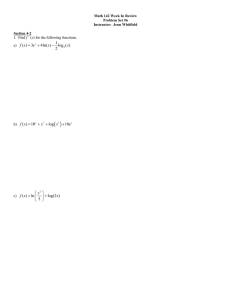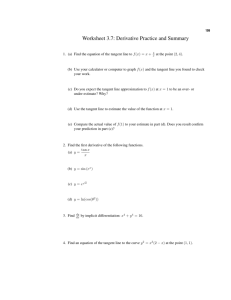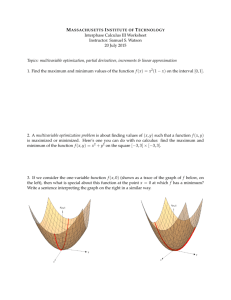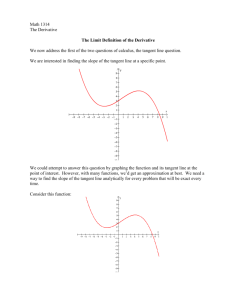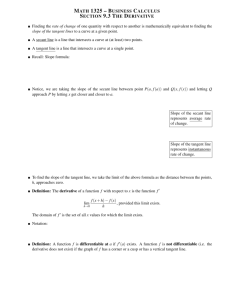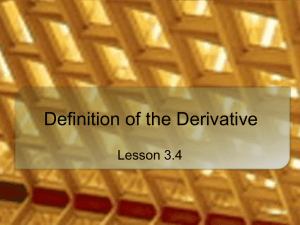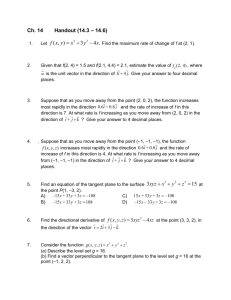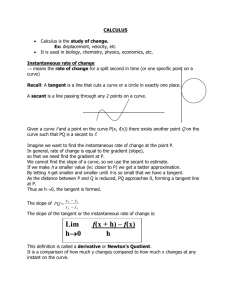lecture6
advertisement
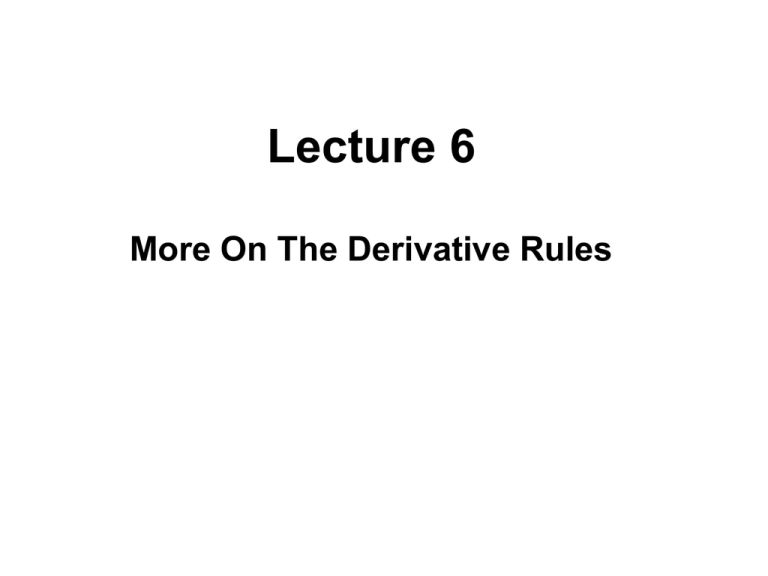
Lecture 6 More On The Derivative Rules Derivative Rules 1. If f is a function and c a constant then (cf) ‘ = c (f ‘) 2. If f and g are functions then (f+g) ‘ = f ‘ + g ‘ 3. (Leibnitz Rule) If f and g are functions then (fg) ’ = f ’ g + f g ’ Where Does Product Rule Come From? Recall key idea: For the purposes of studying a function f “near a” we can replace f by the function whose graph is the tangent line to f at x = a. If we have f and g we replace each by the tangent at x=a f -> f(a) + f ‘ (a)*(x-a) and g -> g(a) + g ‘(a)*(x-a) Then fg gets replaced by their product f(a)g(a) (f '(a)g(a)+f(a)g '(a)) ( x a ) f '(a)g'(a) ( x a ) The derivative of this is (f '(a)g(a)+f(a)g '(a)) Which when x = a is 2 f '(a)g'(a) ( x a ) f '(a)g(a)+f(a)g '(a) 2 More Derivative Rules f 4. Quotient Rule 5. Power Rule ( g )‘ = (f )‘ n f ' g f g' g 2 ( n 1 ) nf f ‘ Power Rule Most often Encountered in Following Form 5 6 Find f ‘ (x) if 5 f ‘( x) = 3 f ( x ) ( x 3 x ) 5 1 6 3 ( x 3 x ) ' 3 ( x 3 x ) 6 f ‘( x) = 5 6 5 1 6 3 ( x 3 x ) ( 9 x 2 ) Chain Rule 6. f(g) ' f ' ( g ) g ' Power rule is a special case where f( x ) x n There are really only 3 rules 1. Additivity 2. Product rule 3. Chain rule The others come from these – Doesn’t hurt to remember the six. h Quotient Rule Comes from the Product Rule f g f g h (g h ) ' g ' h g h ' f ' g ' f g g h ' f ' g g ' f g 2 h' f ( g ) ' f ' g g ' f g 2 Power Rule Comes from Chain Rule Want Then (f n )' Let n f p( f ) p( x ) x n so we are looking for (p(f)) ’ By chain rule (p(f)) ’ = p ‘ (f)* f ‘ p '(x) n x ( n 1 ) (f )‘ n so p '(f) f ( n 1 ) nf f ‘ ( n 1 ) Rules Apply to More than Formulas • The (red) graph of f(x) is given at right and the blue lines are tangent lines to the graph. Using information from the graph and the derivative rules estimate h’(3) where h( x ) x f(x) Solution: h ‘ (x) = (x ‘) f(x) + x f ‘ (x) = f(x) + x f ’(x) h ‘(3) = f(3) + 3 f ‘ (3). From the graph we estimate that f(3) = -3 and f ‘ (3) = -3/2 so we estimate h ‘ (3) = -3 + 3 (-3/2) = -15/2 Example Suppose f and g are functions such that f(5) = 4, f ‘ (5) = 7, g(5) = -3, g ‘ (5) = 2. What is the equation of the tangent line to the graph of h(x) = (fg) (x) at x = 5? Solution: (fg)(5) = f(5)(g(5) = (4)(-3) = -12. (fg)’ (x) = f ‘(x)g(x) + f(x)g ‘(x) so (fg)’(5) = f ‘ (5)g(5) + f(5)g ‘ (5) = 7(-3) + 4(2) = -13. y = (fg)(5) + (fg)’(5)(x-5) y = -12 -13(x-5) Example Suppose f is a function such that f(8) = -3 and f ‘ (8) = 5. What is the slope of the tangent line to the graph of h( x ) ( 2 x f( x ) ) 9 at x = 8? Sln: 8 h ' (x) 9 ( 2 x f( x ) ) ( 2 f ' ( x ) ) 8 h ' (8) 9 ( 2*8 3 ) ( 2 5 ) Example Suppose f and g are functions such that f(7) = 2, f ‘(7) =11 g(3) = 7, and g ‘ (3) = 4.What is the equation of the tangent line to the graph of h(x) = f(g)(x) at x = 3? y – h(a) = h ‘ (a) ( x –a) y – h(3) = h ‘ (3) ( x –3) y – f(g(3)) = f ‘ (g(3))g ’(3) ( x –a) y – f(7) = f ‘ (7)*4* ( x –a) y – 2 = 11*4* ( x –a) or y = 2 +44 ( x –a) Example Suppose f is a function such that f(4) = 5 and f ‘(4) = 2. What is the slope of the tangent line at x = 2 to the graph of x h( x ) 2 f ( x ) x 2 x ' ( f ( x ) x ) x ( f ' ( x ) 2 x ) h ' ( x ) 2 2 ( f ( x ) x ) h ' ( 4 ) 2 1 ( f ( 4 ) 4 ) 4 ( f ' ( 4 ) 2*4 ) 2 2 ( f ( 4 ) 4 ) h ' ( 4 ) 13 121

